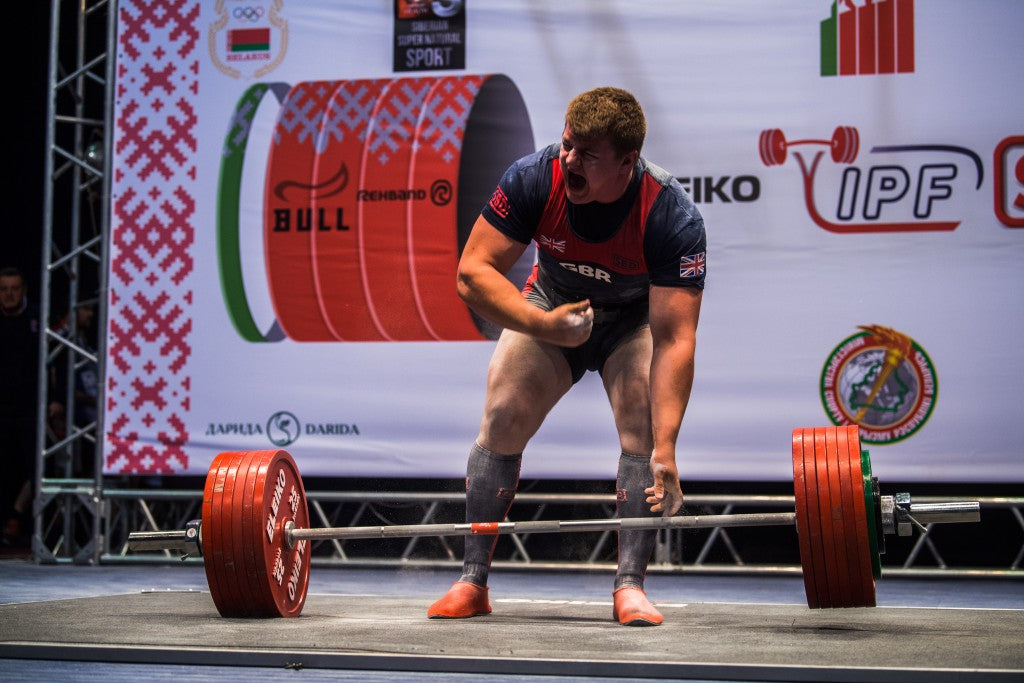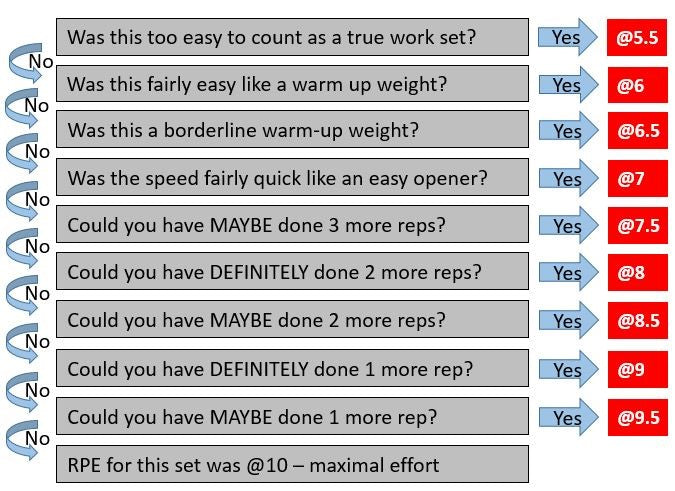How to Use RPE in Your Training *Correctly*
 By Mike Tuchscherer, 5 December 2017
By Mike Tuchscherer, 5 December 2017
You may see people using the term “RPE” regarding their training, but not be sure what it’s all about. Or, more likely, you are one of the people who *thinks* you know what it’s about, but still make fundamental errors with it. No matter which one you are, or even if you do for sure get RPE training correct, hopefully you can learn something from this post.
“RPE” stands for Rate of Perceived Exertion. It’s basically a measure of difficulty for the previous set. Since it’s just a subjective rating of difficulty, you can use RPE for basically anything. In fact, the concept of RPE has its roots in endurance training. But for the purposes of Powerlifting and related strength training, I’ve promoted the following scale for the last decade and it’s received fairly wide adoption:

As you can see, it’s a scale from 1 to 10 and it’s an assessment of your performance during the set. It’s all benchmarked off of a 10 RPE being a maximum effort set – the hardest set you can complete, but you do still complete it.
Tips for rating your RPE
- Don’t think about it during the set. Just execute the set. Focus on your technique or whatever you need to think about.
- As soon as you can after you rack the barbell, go through the flow chart to rate your set to the best of your ability.
- Progress not perfection. If you can’t rate perfectly, you can still derive benefits from the system. Plus you’ll get better with practice.
- Your assessment will depend on how you lift. If you’re a real grinder, your 9RPE sets will be slower than someone who can’t grind very well.
There are many benefits to using RPE in your training
- Allows precise communication with coaches and teammates. It’s more precise than “that felt heavy” or “that felt easy”.
- Allows us to auto-regulate the load. That is to say it lets the load adjust to fit your performance. If you’re getting stronger faster than we expected, we can take advantage of it by increasing the load. If you’re having a bad day, we can adjust the weights down to compensate.
- Allows us to calculate lots of other cool stuff like Stress Index and we can get a better idea of what kinds of protocols each lifter responds best to.
- Allows us to estimate a 1RM (e1RM). This is a really useful way to gauge progress during the course of the training cycle as well as determine what types of training a lifter responds best to. If the estimation is accurate (which in most cases is never more than a custom-RPE chart away), then it can also provide input on attempt selection in a competition.
- You don’t have to have an accurate 1RM on every lift to train effectively. In order for your percentages to be accurate, you need to have an accurate 1RM. If you use assistance exercises, that means a 1RM (or at least an estimate) for all of those movements. And the more inaccurate it is, the further off your training weights will be. RPE on the other hand doesn’t require that and it’s generally self-correcting as you go.
But like any tool, it does have some drawbacks
- It’s difficult to rate low-RPE sets precisely. That combined with low consequences for imprecision in the load means that for low-RPE work, I’ll typically opt for a percentage instead to reduce confusion.
- RPE requires honest assessments. If you can’t rate it honestly because you have too much ego involved, then it won’t work for you.
- RPE requires a bit of aggression. The best attitude to take is controlled-aggressive. If it was left up to you, you’d add a little more weight to the bar. You feel better when adding weight to the bar. But you’re controlled enough to resist that urge if it’s not a smart idea.
- It functions better when there is a familiarity with the movement.
And then there are the misconceptions
- It’s not about your feelings. There’s a notion that, beyond a certain point, everything “feels heavy”. RPE isn’t about that. It’s about your exertion relative to a maximum effort. It’s about performance more than emotions.
- Reps-In-Reserve is a concept that fits within the RPE framework. We use it as part of the rating for higher effort sets in rep-based exercises. But other exercises can use RPE as well (Farmer’s walk, snatch, time based movements, etc). It just won’t use the same descriptions for each rating.
- You should have target weights. Don’t go to the gym with no idea of what you’re doing. A target weight to aim at will improve your training. RPE will then allow you to fine-tune that weight up or down based on how you’re performing at that time. This will also allow you to do visualizations and have the additional motivational factors that target weights can provide.
- If your warmups feel bad, don’t panic right away. If this is normal for you, then it’s just normal and you should proceed normally. If things feel worse than normal, then proceed with caution. You may come out of your funk with an extra warm up. If not, adjust the weights. That’s what RPE is for. But it needs to be in relation to what is normal for you.
These are some fundamentals of using RPE properly in your training. I hope this helps you put the right weight on the bar and lift it the right number of time. After all, that is the goal of training and RPE is a great tool to have in your toolbox.
Footer: If you enjoyed this article, please share it. Join the conversation on our RTS Facebook page. If you want more stuff like this, plus exclusive content not posted elsewhere, please sign up for our Email Newsletter. About the Author: |
About the Author Mike Tuchscherer is the owner and head coach at RTS. He has been powerlifting since 2001 and since has traveled all over the world for competitions. In 2009, he was the first man from USA powerlifting to win a gold medal at the World Games – the highest possible achievement in powerlifting. He has coached over a dozen competitors at the world championships, a score of national champions, and multiple world record holders. |